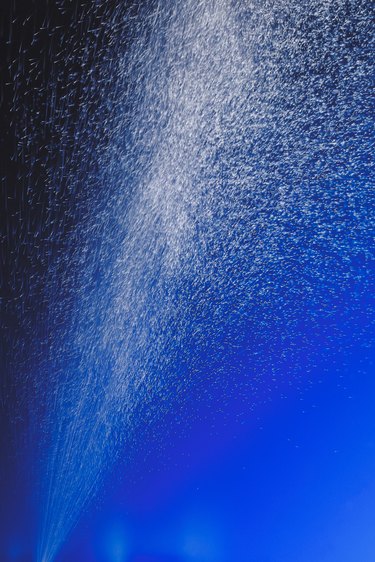Things You'll Need
Liquid strainer or filter
Air atomizing nozzle
Air compressor
Pressure regulator with gauge
Spray pipe assembly
Polyetheylene tubing
Pipe hanger or side-mounting assembly
Air filter
Solenoid valve
Switching relay
Humidistat
Sling psychrometer or hand-held humidity tester

There are many practical applications for atomizing water with pressure. These include hydraulic and air atomizing systems. Hydraulic spray systems apply pressurized water to nozzles for many different applications and include evaporative cooling and the spray of pesticides or liquid fertilizers on crops. Air atomizing systems, in contrast, mix air with water to create fine droplets or fogs for humidification and cooling purposes. Each type of spray system has specific nozzles and pressure requirements in order for the atomization to occur properly. Knowing the amount of water delivery that is needed is the first step in designing a water atomizing system.
How to Make an Air Atomizing System
Step 1
Determine the amount of water delivery that is needed. For humidification systems, the amount of water delivery is based on the volume of the area of the room or building that is heated by an HVAC system. Calculate the square footage and the ceiling height of all rooms in the building. Tables can be found on the Internet that have this information. For example, a 1,000 cubic foot room requires from 0.5 to 10 gallons per day of water for humidification. There is a large range because the amount needed depends on the tightness of the building's construction.
Video of the Day
Step 2
Select the type of nozzle that fits the needs for water consumption. Manufacturers have nozzles listed either by gallons per day or gallons per hour. Make the conversion to gallons per day if needed. Find the required air pressure and purchase an air compressor that provides both the adequate pressure and volume needed for atomization. Purchase the miscellaneous supplies that are needed to install the nozzles and mount them where needed.
Step 3
Assemble the atomization system. First assemble the tubing needed for the water side and the water strainer. Install the nozzles into fittings provided in the tubing. Include a ball valve for cutting off the water supply for maintenance purposes. The air line after the compressor includes the following components, in order: air filter, pressure regulator, solenoid, and switching relay. The switching relay is attached to the humidistat, which turns on the system when the humidity is below the desired set point. After the solenoid, a T is installed. On the downside of the T a ball valve is connected for draining and maintenance. On the upper half of the T fitting, the pressure lines connect to the air side of the atomizing nozzles.
Step 4
Mount the pipe or hose assembly into the area where the atomized water is to be applied. Mounting systems will vary, perhaps including pipe hangers or mounting along a pipe inserted into an air duct. If the system is being mounted onto an air duct, make sure that the insulation is replaced to prevent air leakage.
Step 5
Install the humidistat and connect the wiring to the air solenoid. Connect the power to the humidistat and turn on the water supply to the nozzles. Check the system for proper operation and cycling. For verification of humidity settings, use a sling psychrometer or a hand-held humidity tester.
Tip
If the water for the system has a high amount of bicarbonates, then water treatment chemicals may be necessary to prevent clogging of the nozzles. Special nozzles are also available that are self-cleaning or that have cleaning pins.
If you assemble the system with tubing or small-diameter pipe, consider the use of push-connect fittings for joining the sections. Assembly is fast and does not require gluing.
Warning
Check to make sure that the pressure is set properly for atomization to occur.
Have an electrician install a relay in the system, so that when there is no air flow in front of the atomizing nozzles, the atomizing system is shut off.
Some atomization systems also include shut-off relays that are connected to a humidity detector installed in front of the atomizers.
Video of the Day